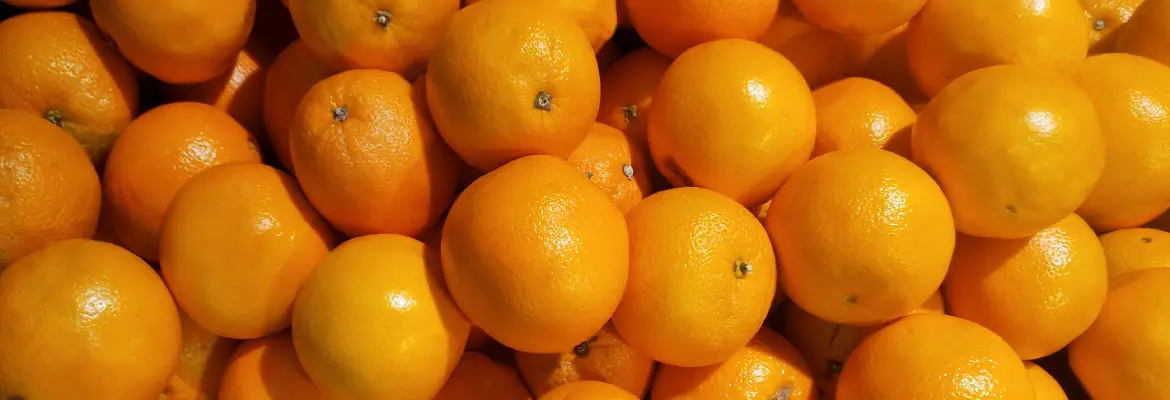Mandarin is a small citrus fruit having round to ovate shape. Mandarin resembles a small, slightly squashed orange with orange to red-orange peel surrounding the sectioned, juicy flesh.
Mandarin has a deep orange, loose semi- thin, easy to peel, glossy, smooth, pebble textured skin and has a sweeter and less acidic taste than common orange.
Mandarin’s flesh has 10-12 segments which are seedless or seeded, aqueous and soft.
Average diameter of mandarin is 5-9 cm (2 – 3.5 inches). Average weight of a mandarin can range from 80 -120 gram (0.17 – 0.26 pounds or 2.8 – 4.2 ounces).

Scientific name of Mandarin
Citrus Reticulata
Other names of Mandarin
- Mandarine
- Mandarin Orange
- Kid-glove orange
Calories by source in Mandarin
- Calories by carbohydrate in Mandarin = 90%
- Calories by fat in Mandarin = 5%
- Calories by protein in Mandarin = 5%
Fats and Fatty Acid profile of Mandarin
- Polyunsaturated fat (PUFA) in Mandarin = 40%
- Saturated fat (SFA) in Mandarin = 24%
- Monounsaturated fat (MUFA) in Mandarin = 36%
Nutrition facts of Mandarin
*Serving size = 100 grams = 3.55 Ounces = 1/2 cup
*DV= % Daily Value (%DV indicates how much nutrients contribute to a person’s daily diet from a serving of a food. DV assists you in determining whether or not a serving of food is high or low in a particular nutrient.)
| Nutrient | Amount | Unit | DV |
|---|---|---|---|
| Calories | 53 | KCAL | |
| Fat | 0.31 | GRAM | 0% |
| Protein | 0.81 | GRAM | 2% |
| Carbohydrate | 13.34 | GRAM | 5% |
Detailed vitamin profile of Mandarin, vitamin A, vitamin B12, vitamin B6, vitamin C, vitamin D, Folate, Niacin, Thiamin, and Riboflavin is shown in the chart.
Detailed mineral profile of Mandarin, Sodium(Na), Calcium(Ca), Copper(Cu), Iron(Fe), Magnesium(Mg), Selenium(Se), Phosphorus(P), Potassium(K) and Zinc(Zn) is shown the chart.
Check freshness in Mandarin
- Mandarins have a pronounced crown. The base of the crown should not be weak
- Choose unblemished and dense mandarins
- Unripe mandarins are green in color
- Mandarin should be firm and not be soft or spongy
- Bad mandarins will have brown patches and some brown patches will be wet and moldy and when pressed will crack the skin
- Old mandarins will be dull in color and shine and the skin is easily cracked when gently squeezed
- Old mandarins become dry and wrinkly
- Avoid mandarins with cracked crown
Availability of Mandarin
- The Seasons of mandarin depend on the geographical location where it is being cultivated
- Canada – Mandarin season ranges from November – March
- USA – Mandarin season ranges from November – March
- Turkey – Mandarin season ranges from October – April
- Egypt – Mandarin season ranges from December – May
- India – Mandarin season ranges from November – January and March – May
How to store Mandarin
- Ripe mandarins can be stored easily at room temperature for 3-4 days
- Ripe mandarins can be stored in refrigerator for 10-14 days
- Refrigerated acorn squash can last for 2 weeks
- Due to its high moisture content, mandarins freeze well.
- Freeze mandarin pieces for 2 -3 hours on a tray. Once completely frozen, the pieces can be stored in an airtight bag or container for months
Complete nutrition facts of Mandarin
Click on the link HERE to download high quality, high resolution and print ready PDF version of the Mandarin nutrition chart/infographic.


